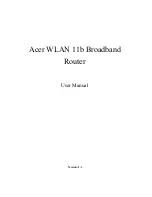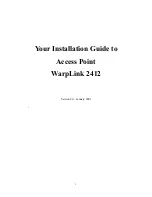
16
17
2. Static
In this configuration, IP address and network mask have to be given.
These settings have to be written down since the web interface can only be accessed by
these settings.
3. DHCP server
(only with static IP address possible)
In this configuration, the
alpha LTE/UMTS 4/EDGE HS
can assign IP addresses via DHCP
itself. Next to the configuration of the IP address as well as the network mask, a range
from which IP addresses can be assigned has to be given.
Please note:
The same IP addresses on several interfaces have to be avoided and normally
lead to a malfunction. The network masks should only be chosen that way that the
particular networks do not overlap.
Firewall (only as router)
The
alpha LTE/UMTS 4/EDGE HS
has a simple firewall to block incoming connections
(from the WAN) and to allow outgoing connections. Furthermore, services can be for-
warded to members of the LAN via port forwarding. For the remote configuration, TCP-
Port 80(HTTP), 443(HTTPS) and 22 (SSH) have to be released. Port forwarding of these
interfaces should also be avoided.
For the port forwarding and the remote access you have to keep in mind that many
providers do not assign public IP addresses.
OpenVPN Client (only as router)
The
alpha LTE/UMTS 4/EDGE HS
can take part in a virtual private network as
OpenVPN Client. Next to the encoding of the data, it provides the opportunity for remote
maintenance with the router or devices behind the router which is not possible in most
networks without VPN because of a missing public IP address.
The log records are only intended for debugging purposes. After successful constitution
of the tunnel, logging should be deactivated again.
There are 2 operating modes:
With an IP tunnel (tun), a point-to-point connection between server and
alpha LTE/UMTS
4/EDGE HS
is established. Units in the LAN can then be accessed via port forwarding or
corresponding routes in the server.
With a bridge (tap), all routable packets are forwarded. Then the units can be accessed
directly, but a larger data traffic is caused. DHCP is also forwarded and can cause big
problems in the VPN.
For the authentication next to optional username and password, either a PKCS12
certificate, a statical key or a CA certificate can be used.
IPSEC
IPSEC tunnel can be configured in the web interface. Give a meaningful name for the tun-
nel. Two Methods for coding will be aided: shared keys as well as certificates.
The way of coding can be configured in IKE Policy for the phase 1 and in IPSEC Policy for
the phase 2. Dead-Peer Detection has to be configured in Advanced Settings.
Configuration over the web interface
Содержание alpha EDGE HS
Страница 25: ...25 Menu scheme web interface alpha LTE UMTS 4 EDGE HS Menu scheme ...
Страница 26: ...26 Menu scheme ...













































